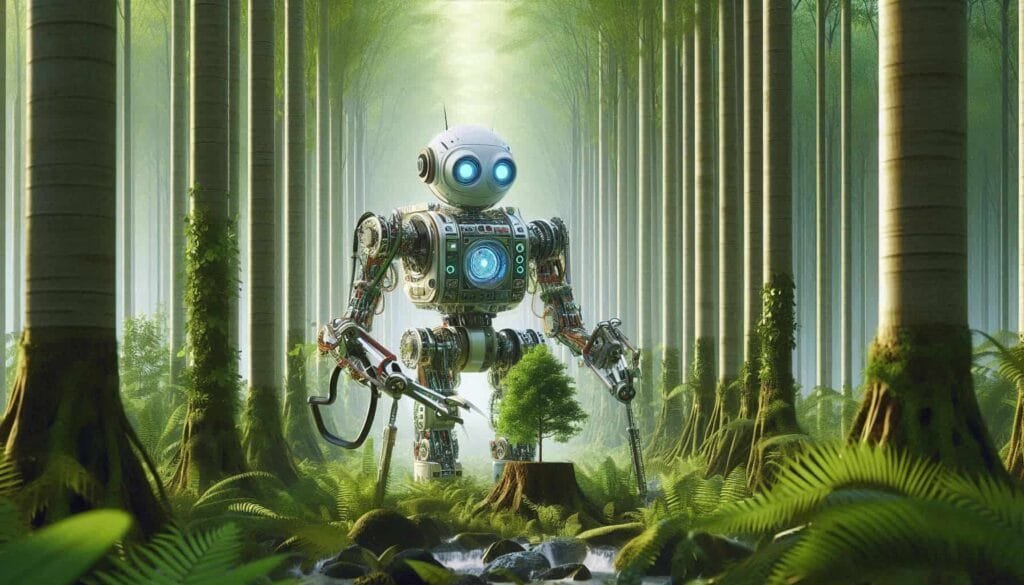
In a society where habitat loss and climate change are progressively influencing everything, creative ideas are very vital. Now let me introduce the reforesting robot, a marvel of technology meant to stop deforestation and heal degraded habitats. Offering a potential answer to one of the most urgent problems on Earth, reforestation robots are autonomous or semi-autonomous machines that plant trees and other vegetation at a scale never possible.
The Environmental Impact of Deforestation
The Scope of Deforestation
Urban growth, farming, and logging claim millions of hectares of forests annually. This destruction of forests disturbs ecosystems, reduces biodiversity, and greatly increases carbon emissions, therefore aggravating climate change.
Consequences of Forest Loss on Ecosystems and Climate
Tree loss lowers the Earth’s capacity for natural carbon-sequesters, which increases atmospheric greenhouse gas concentrations. Deforestation also disturbs wildlife habitats, soil integrity, and water cycles, therefore compromising many different species.
How Reforesting Robots Work
Combining artificial intelligence, machine learning, and drone technology, reforesting robots find ideal planting sites, disperse seeds, and track development. Some may even negotiate several terraces, therefore guaranteeing the exact focus of forestry initiatives.
Types of Reforesting Robots
Drone-Based Reforestation
Aerial reforestation frequently employs drones. As they map planting zones and track development, they fly over focused areas distributing seeds with accuracy.
Ground-Based Reforesting Robots
Operating nearer the ground, ground-based robots plant seedlings using mechanical arms or specifically engineered appendages. These robots shine on challenging terrain, where drones could encounter problems.
Advantages of Reforesting Robots
Speed and Efficiency
Planting thousands of trees in a day, reforesting robots operate faster than human efforts. In extremely deforested areas needing quick recovery, this speed can be crucial.
Cost-Effectiveness
Robotic reforestation frequently lowers long-term costs by reducing labor expenses and raising planting success rates, even if the initial technological investment can be significant.
Precision and Consistency
Reforesting robots improve their survival rates and probability of successful development by using advanced mapping and artificial intelligence to guarantee that seeds are placed in the best possible sites.
Challenges in Using Reforesting Robots
Technological Limitations
Reforesting robots may have difficulties with uneven or thick ground even with their sophisticated capabilities. Their performance might also be hampered by temperature and battery life.
Terrain and Environmental Obstacles
Some ecosystems are too challenging for even the most advanced robots to navigate, such as areas with thick foliage or steep inclines.
Initial Costs and Investment
Robotic reforestation can have large upfront expenses that call for large resources and money, therefore restricting accessibility for smaller initiatives or companies.
Case Studies: Successful Reforesting Robot Projects
Robotic reforestation initiatives have been started by several companies all around with amazing success. Especially, a BioCarbon Engineering project in Myanmar planted thousands of mangrove trees using drones to show how well drone-based reforestation works in coastal environments.
Comparing Traditional Reforestation to Robotic Reforestation
Labor and Time Comparison
Labor-intensive and slow is human-led reforestation. Conversely, robots speed the planting process and reduce physical effort since they automate it.
Effectiveness and Coverage
Robotic reforestation often results in better coverage and higher tree survival rates due to the precision planting techniques employed by the robots.
Future of Reforesting Robots
Technological Innovations on the Horizon
Reforestation robots should get more flexible and resilient as artificial intelligence and robotics keep developing. Innovations might include robots able to use renewable energy sources or operate in more demanding surroundings.
Potential for Widespread Adoption
Reforestation robots, with their ongoing effectiveness, might become a regular tool in large-scale environmental restoration particularly in places badly affected by deforestation.
Environmental Impact of Reforesting Robots
Carbon Sequestration
By planting trees, reforesting robots actively contribute to carbon sequestration, a process essential for offsetting emissions and mitigating climate change.
Biodiversity and Habitat Restoration
Beyond climate benefits, reforesting robots help restore habitats, promoting biodiversity by providing new habitats for various species.
The Role of Artificial Intelligence in Reforesting Robots
How AI Enhances Planting Accuracy
Reforestation robots enabled by artificial intelligence can examine topographical features, soil quality, and moisture to find ideal planting locations. This accuracy improves the rates of survival and development for planted trees.
Role in Data Collection and Analysis
Additionally gathering important environmental data, reforesting robots can help to monitor ecosystem health and guide next planting plans.
Financial and Economic Implications of Reforesting Robots
Cost Comparison to Traditional Methods
Robotic replanting could eventually prove to be less expensive than conventional techniques, particularly in areas where human access is restricted or labour expenses are high.
Job Opportunities and Industry Growth
Although in some places reforestation robots lessen the need for human labor, they also provide opportunities in environmental management, robot manufacture, and maintenance.
Collaborative Efforts in Robotic Reforestation
Partnership Between Technology Firms and Environmental Organizations
Many reforesting projects are collaborative, with tech companies partnering with NGOs to scale reforestation efforts and improve the technology.
Involvement of Governments and NGOs
cash and controlling massive reforestation efforts depend on government backing; NGOs offer knowledge in environmental preservation but not cash.
Potential Drawbacks and Concerns
Environmental Impact of Manufacturing Robots
Reforestation robot manufacture comes with environmental costs. Though the long-term advantages of reforestation usually exceed any negative environmental impact of the production process and materials employed.
Risk of Over-Reliance on Technology
Although reforestation robots have advantages, they should not replace human participation in conservation since sustained replanting depends on a mix of technology and community work.
Conclusion
An interesting road forward in the worldwide battle against deforestation and climate change is provided by reforestation robots. These robots can restore large areas by combining speed, accuracy, and technology, therefore offering hope for a cleaner future. Although there are still difficulties, robotic reforestation is a viable alternative that, given enough support and innovation, might help undo the negative consequences of deforestation on our earth.
FAQs
- What are reforesting robots?
Reforesting robots are autonomous or semi-autonomous machines designed to plant trees and restore ecosystems in deforested areas efficiently. - How do reforesting robots work?
These robots use technologies like drones, AI, and machine learning to identify optimal planting spots, distribute seeds, and monitor growth. - Are reforesting robots environmentally friendly?
Yes, they help reduce carbon emissions and restore habitats, although their manufacturing does have a minor environmental impact. - Can reforesting robots replace human reforestation efforts?
While they’re highly efficient, they work best alongside human efforts and should not completely replace traditional conservation methods. - Where are reforesting robots currently used?
Reforesting robots have been deployed in countries like Myanmar and Australia, as well as in other regions needing large-scale reforestation.

